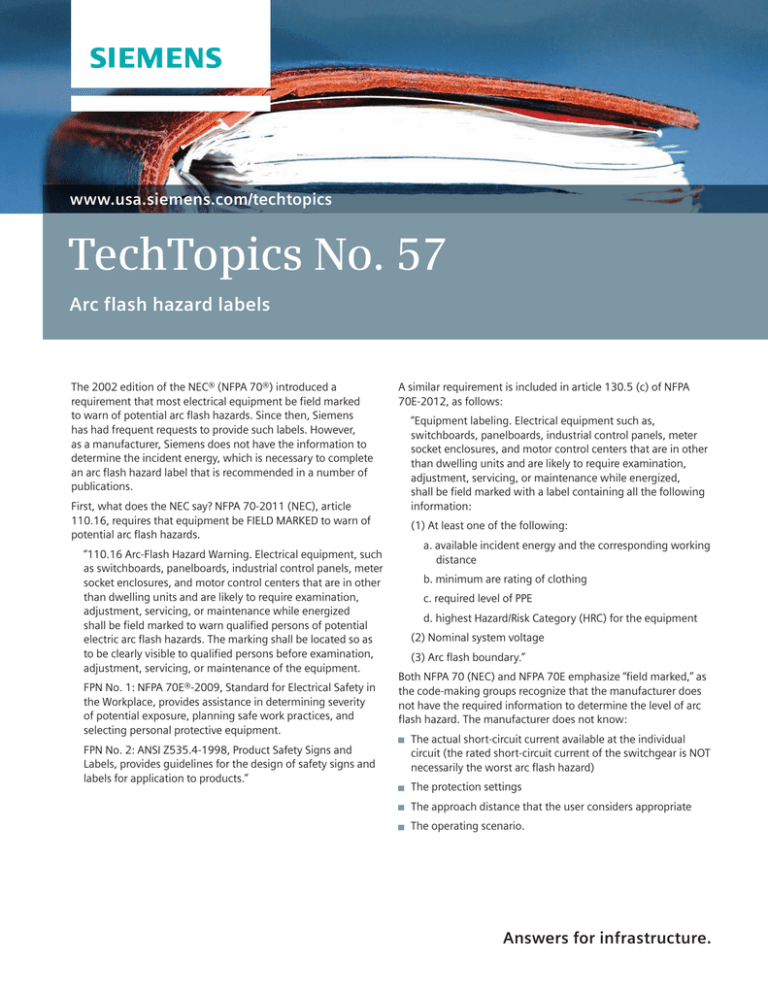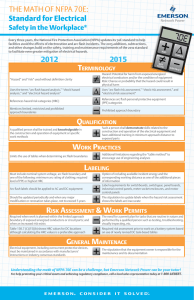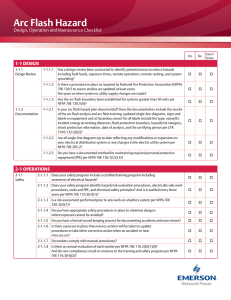TechTopics No. 57 Arc flash hazard labels www.usa.siemens.com/techtopics
advertisement

www.usa.siemens.com/techtopics TechTopics No. 57 Arc flash hazard labels The 2002 edition of the NEC® (NFPA 70®) introduced a requirement that most electrical equipment be field marked to warn of potential arc flash hazards. Since then, Siemens has had frequent requests to provide such labels. However, as a manufacturer, Siemens does not have the information to determine the incident energy, which is necessary to complete an arc flash hazard label that is recommended in a number of publications. First, what does the NEC say? NFPA 70-2011 (NEC), article 110.16, requires that equipment be FIELD MARKED to warn of potential arc flash hazards. “110.16 Arc-Flash Hazard Warning. Electrical equipment, such as switchboards, panelboards, industrial control panels, meter socket enclosures, and motor control centers that are in other than dwelling units and are likely to require examination, adjustment, servicing, or maintenance while energized shall be field marked to warn qualified persons of potential electric arc flash hazards. The marking shall be located so as to be clearly visible to qualified persons before examination, adjustment, servicing, or maintenance of the equipment. FPN No. 1: NFPA 70E®-2009, Standard for Electrical Safety in the Workplace, provides assistance in determining severity of potential exposure, planning safe work practices, and selecting personal protective equipment. FPN No. 2: ANSI Z535.4-1998, Product Safety Signs and Labels, provides guidelines for the design of safety signs and labels for application to products.” A similar requirement is included in article 130.5 (c) of NFPA 70E-2012, as follows: “Equipment labeling. Electrical equipment such as, switchboards, panelboards, industrial control panels, meter socket enclosures, and motor control centers that are in other than dwelling units and are likely to require examination, adjustment, servicing, or maintenance while energized, shall be field marked with a label containing all the following information: (1) At least one of the following: a. available incident energy and the corresponding working distance b. minimum are rating of clothing c. required level of PPE d. highest Hazard/Risk Category (HRC) for the equipment (2) Nominal system voltage (3) Arc flash boundary.” Both NFPA 70 (NEC) and NFPA 70E emphasize “field marked,” as the code-making groups recognize that the manufacturer does not have the required information to determine the level of arc flash hazard. The manufacturer does not know: The actual short-circuit current available at the individual circuit (the rated short-circuit current of the switchgear is NOT necessarily the worst arc flash hazard) The protection settings The approach distance that the user considers appropriate The operating scenario. Answers for infrastructure. All of these factors, and more, affect the calculations of arc flash incident energy. This is why the NFPA 70 (NEC) and NFPA 70E established the requirement for labeling as a field requirement imposed on the user, not a requirement for the manufacturer. Standards and code issues Article 110.16 of the NEC requires that equipment be field labeled to warn of potential arc flash hazard. Article 130.5 of NFPA 70E-2012 requires a flash hazard analysis to determine the flash protection boundary and the personal protective equipment required for persons within the flash protection boundary. Article 130.5 specifies several methods that can be used. One is the “classic” Ralph Lee formula from a 1982 technical paper. Another calculation method is the scheme developed by the IEEE 1584 working group several years ago and embodied in IEEE 1584-2002. Both of these methods have been widely incorporated in commercially available short-circuit calculation programs, and the more well known of these programs give the user the option of using either the Ralph Lee formula or the IEEE 1584 method. The IEEE 1584 method generally yields results that are less conservative than the Ralph Lee method. Regardless of method, the system short-circuit current available at the fault location must be known, and more importantly, the time duration of fault current flow. This requires knowledge of the protective settings of the circuit, including the time-current characteristics (TCC), pickup settings and time settings. It also requires knowledge of the operating scenario (such as, number of sources, closed or open tie, paralleled mains, etc.). The manufacturer does not know all of these critical information elements. It is not appropriate to assume that the actual system short-circuit current available is equal to the maximum rating of the switchgear, as the worst case for the amount of incident energy may correspond to a lower value of short-circuit current with a longer time duration. The worst case often occurs just below the point of transfer between the long-time portion of the TCC curve on a low-voltage trip device, and the next (higher current) characteristic, be it short-time or instantaneous. Similarly, the worst case on medium-voltage switchgear probably is not at the maximum fault rating of the switchgear, where the tripping delay of the protective relay will always be shortest. Likewise, it is not appropriate to assume that all protective device settings will be at the maximum of the setting range, as this would yield a value of incident energy completely out of touch with reality, and would require an unnecessarily high level of personal protective equipment. In addition to producing a very overestimated value for incident energy, use of the highest possible settings would represent a severely mis-coordinated system in almost all cases. Since the manufacturer can’t know the critical facts, and the facts change whenever the installation is reconfigured or the operating scenario changes, both NEC and NFPA 70E require that equipment be field labeled. The relevant documents are the NEC, NFPA 70E, IEEE 1584 and a great many technical papers. Most of the commercially available short-circuit program vendors also provide information on calculation of the arc flash hazard level, as do the suppliers of personal protective equipment. Specialty label firms (e.g., Hazard Communications at www.safetylabel.com) have a wide variety of labels available, such as the generic label shown below. While this shows a generic label from one firm, other suppliers have labels that are of a similar nature. Generic arc flash label (from www.safetylabel.com) A generic label warns of the arc flash hazard but does not list the flash protection boundary that is discussed in NFPA 70E, or define the personal protective equipment required. The flash protection boundary distance varies for each circuit in the lineup, and also varies depending on the operating scenario (such as, tie closed or not, local generation on or not). These issues are both addressed in a special label shown in the next column. This label is of similar format to that first proposed by DuPont, one of the main driving forces in the creation of IEEE 1584. This label requires that all information shown in red be provided for each individual label. Thus, each label for each compartment of the switchgear will be unique. Detailed arc flash label from www.safetylabel.com) The detailed label clearly shows why the equipment must be field marked with the hazard information. The user should have short-circuit calculations performed by a competent engineer, preferably using one of the commercial short-circuit calculation programs to determine the short-circuit current available. Most (if not all) of the commercially available short-circuit calculation programs now have a module to calculate the incident energy, with options to use the IEEE 1584 method or the Ralph Lee method. The manufacturer does not have the required information to determine the incident energy or the flash protection boundary, and therefore, the manufacturer cannot put this information on an equipment label. References: NFPA 70-2011 (NEC) National Electrical Code® NFPA 70E-2012 Standard for Electrical Safety in the Workplace IEEE Std 1584-2002, IEEE Guide for Performing Arc Flash Hazard Calculations The information provided in this document contains merely general descriptions or characteristics of performance which in case of actual use do not always apply as described or which may change as a result of further development of the products. An obligation to provide the respective characteristics shall only exist if expressly agreed in the terms of contract. All product designations may be trademarks or product names of Siemens AG or supplier companies whose use by third parties for their own purposes could violate the rights of the owners. Siemens Industry, Inc. 7000 Siemens Road Wendell, NC 27591 Subject to change without prior notice. Order No.: E50001-F710-A343-X-4A00 All rights reserved. © 2012 Siemens Industry, Inc. For more information, contact: +1 (800) 347-6659 www.usa.siemens.com/techtopics




